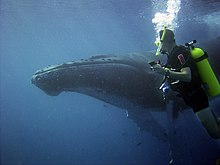Silver Bank
Native name: Banco de la Plata Eastern Caribbean Time Zone (UTC−04:00 ) |
|---|

Silver Bank (
Geography


Silver Bank is a shallow underwater carbonate platform that almost reaches the ocean's surface in certain areas (60 feet (18 metres) deep in the shallow parts), but is mostly submerged. In its northern reaches, many coral heads reach the ocean surface, especially at low tide. Lying amongst the coral heads is the wrecked freighter Polyxeni, most of which rests above the surface. Persons can board the Polyxeni only with governmental permission.
Because the Silver Bank is shallow, it is not suitable for passage of large ships. In fact, any boat in the area should obtain permission before entering the bank.
The area is considered part of the Dominican Republic, as is Navidad Bank east of it. On Oct. 14, 1986, the Dominican Republic established the
The Silver Bank has long been a breeding and calving area for humpback whales.[3] As such, tourism centers around tours to view the whales and other wildlife.
Just to the southeast is Navidad Bank, also under the jurisdiction of the Dominican Republic.
The Silver Bank, the Navidad Bank, as well as the Mouchoir Bank further northwest, plus the Turks and Caicos Islands, are geographically considered a continuation of the Lucayan Archipelago.[4]
See also
References
- ^ Áreas protegidas de la República Dominicana - Santuario de los Bancos de la Plata y de la Navidad
- ^ Michael L. Frankel, The Voyage of SABRA: An Ecological Cruise Through the Caribbean
- ^ Reserva Cientifica Santuario de Mamiferos Marinos Bancos Bancos de la Plata y Navidad Archived 2016-10-25 at archive.today
- ISBN 9780444516442.
External links
